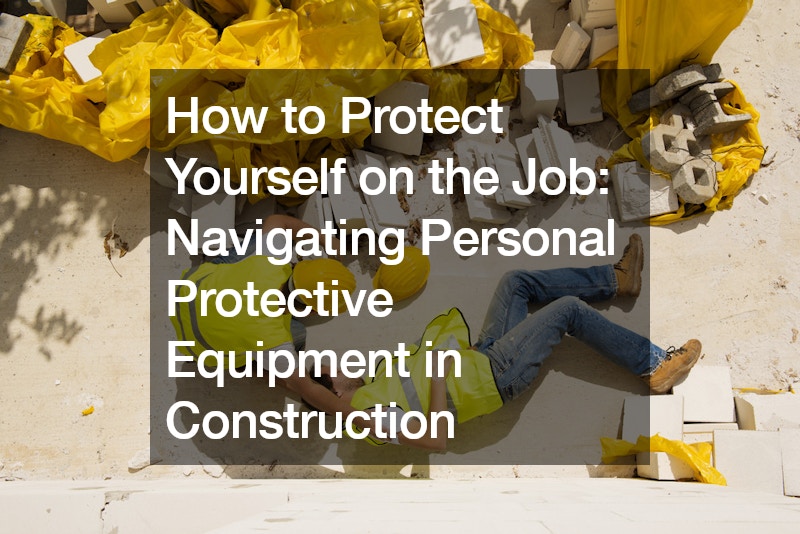In the bustling world of construction, safety is paramount. Whether you’re operating heavy machinery, working with hazardous materials, or navigating busy job sites, personal protective equipment (PPE) is your best defense against workplace hazards. From hard hats to respirators, understanding and utilizing the right gear can mean the difference between a safe workday and a potential injury.
Hard Hats: Protecting Your Head
One of the most fundamental pieces of PPE in construction is the hard hat. Designed to shield your head from falling or flying objects, hard hats are a must-have on any job site.
When wearing a hard hat, ensure it meets safety standards, and replace it if damaged. Remember, it’s not just about wearing it on your head but ensuring it fits properly and remains in good condition.
High-Visibility Gear: Staying Visible
In construction zones where visibility is key, high-visibility garments are essential. These brightly colored vests help alert vehicle operators to your presence, reducing the risk of accidents. Whether you’re working near moving vehicles or in low-light conditions, wearing high-visibility gear is a simple yet effective way to enhance safety on the job.
Eye and Face Protection: Shielding Against Hazards
Your eyes and face are vulnerable to various hazards on a construction site, from flying debris to chemical splashes. That’s why it’s crucial to wear impact-resistant safety glasses or goggles whenever there’s a risk of eye injury. Additionally, face shields provide added protection against impact hazards and chemical splashes. Always ensure your eye and face protection meet safety standards to keep your vision safe.
Safety Footwear: Protecting Your Feet
Construction sites are rife with potential foot hazards, from sharp objects to heavy equipment. That’s why wearing safety footwear with slip-resistant, puncture-resistant soles is vital. Steel-toed or composite-toed boots offer added protection against falling objects and crushing injuries. Remember, tennis shoes won’t cut it on a construction site – invest in proper safety footwear to keep your feet safe.
Hand Protection: Choosing the Right Gloves
Your hands are your most valuable tools on the job, so it’s essential to protect them with the right gloves. Depending on the task at hand, you may need gloves to shield against sharp objects, chemicals, heat, or electricity. Ensure your gloves fit properly and provide adequate protection for the job you’re performing.
Hearing Protection: Safeguarding Your Hearing
Construction sites can be noisy environments, exposing workers to the risk of long-term hearing loss. That’s where hearing protection comes in. Whether you opt for earplugs or earmuffs, make sure they have a high noise reduction rating (NRR) and follow manufacturer guidelines for proper use. Protecting your hearing today ensures you can enjoy it for years to come.
Respiratory Protection: Breathing Easy
Inhalation hazards, such as dust, fumes, and chemical vapors, are common on construction sites. Respirators are designed to filter out these contaminants, keeping your respiratory system safe. Ensure your respirator fits properly and provides the necessary level of protection for the task at hand. Remember, respiratory protection is essential for your long-term health.
Importance of Maintaining a Clean and Organized Work Environment To Prevent Accidents and Injuries
Maintaining a clean and organized work environment is crucial for preventing accidents and injuries on construction sites. Here’s why:
1. Hazard Identification: A tidy workspace allows for better visibility of potential hazards such as debris, spills, or obstacles. Workers can easily identify and address these risks promptly, reducing the likelihood of accidents.
2. Improved Workflow: An organized work environment promotes efficient movement and operation of machinery and equipment. Clear pathways and designated storage areas minimize clutter and confusion, allowing workers to focus on their tasks safely.
3. Reduced Tripping Hazards: Cluttered work areas increase the risk of trips, slips, and falls. By keeping the workspace free of obstacles and debris, workers can navigate the site with confidence, reducing the chance of injuries.
4. Enhanced Safety Culture: A clean and organized work environment fosters a culture of safety among workers. When cleanliness and organization are prioritized, employees are more likely to adhere to safety protocols and maintain vigilance against potential hazards.
5. Equipment Maintenance: Regular cleaning and maintenance of tools and equipment help ensure their proper functioning and longevity. Malfunctioning or damaged equipment poses significant safety risks and can lead to accidents if not addressed promptly.
Conclusion
Navigating personal protective equipment in construction is vital for your safety and well-being on the job. From hard hats to respirators, each piece of gear plays a crucial role in protecting you from workplace hazards. By understanding the importance of PPE and using it correctly, you can ensure a safe and productive work environment. Don’t forget to stay informed about safety standards and regulations, and consider taking a CITB test to demonstrate your knowledge and commitment to workplace safety. Stay safe out there!
.


